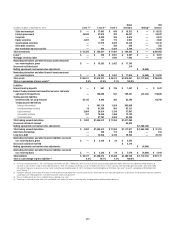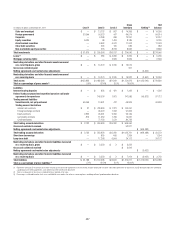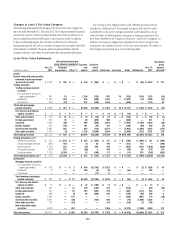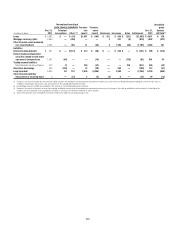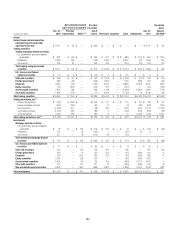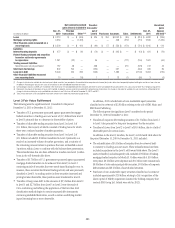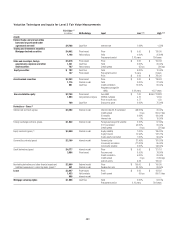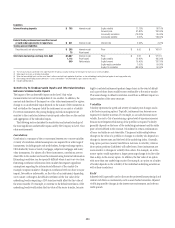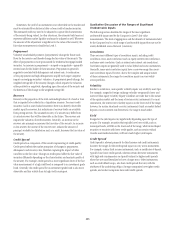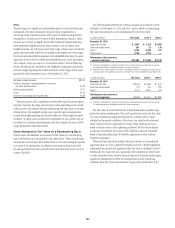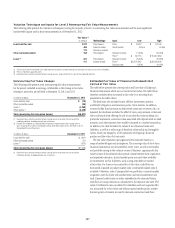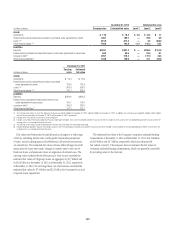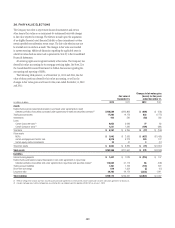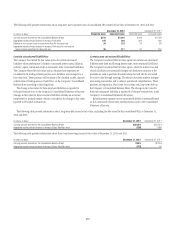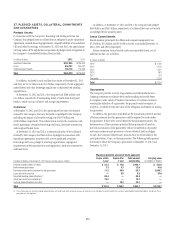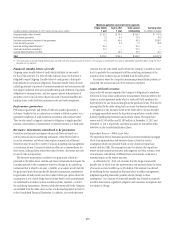Citibank 2012 Annual Report Download - page 287
Download and view the complete annual report
Please find page 287 of the 2012 Citibank annual report below. You can navigate through the pages in the report by either clicking on the pages listed below, or by using the keyword search tool below to find specific information within the annual report.265
Sometimes, the yield of an instrument is not observable in the market and
must be estimated from historical data or from yields of similar securities.
This estimated yield may need to be adjusted to capture the characteristics
of the security being valued. In other situations, the estimated yield may not
represent sufficient market liquidity and must be adjusted as well. Whenever
the amount of the adjustment is significant to the value of the security, the
fair value measurement is classified as Level 3.
Prepayment
Voluntary unscheduled payments (prepayments) change the future cash
flows for the investor and thereby change the fair value of the security. The
effect of prepayments is more pronounced for residential mortgage-backed
securities. An increase in prepayment—in speed or magnitude—generally
creates losses for the holder of these securities. Prepayment is generally
negatively correlated with delinquency and interest rate. A combination
of low prepayment and high delinquencies amplify each input’s negative
impact on mortgage securities’ valuation. As prepayment speeds change, the
weighted average life of the security changes, which impacts the valuation
either positively or negatively, depending upon the nature of the security and
the direction of the change in the weighted average life.
Recovery
Recovery is the proportion of the total outstanding balance of a bond or loan
that is expected to be collected in a liquidation scenario. For many credit
securities (such as asset-backed securities), there is no directly observable
market input for recovery, but indications of recovery levels are available
from pricing services. The assumed recovery of a security may differ from
its actual recovery that will be observable in the future. The recovery rate
impacts the valuation of credit securities. Generally, an increase in the
recovery rate assumption increases the fair value of the security. An increase
in loss severity, the inverse of the recovery rate, reduces the amount of
principal available for distribution and, as a result, decreases the fair value of
the security.
Credit Spread
Credit spread is a component of the security representing its credit quality.
Credit spread reflects the market perception of changes in prepayment,
delinquency and recovery rates, therefore capturing the impact of other
variables on the fair value. Changes in credit spread affect the fair value of
securities differently depending on the characteristics and maturity profile of
the security. For example, credit spread is a more significant driver of the fair
value measurement of a high yield bond as compared to an investment grade
bond. Generally, the credit spread for an investment grade bond is also more
observable and less volatile than its high yield counterpart.
Qualitative Discussion of the Ranges of Significant
Unobservable Inputs
The following section describes the ranges of the most significant
unobservable inputs used by the Company in Level 3 fair value
measurements. The level of aggregation and the diversity of instruments held
by the Company lead to a wide range of unobservable inputs that may not be
evenly distributed across the Level 3 inventory.
Correlation
There are many different types of correlation inputs, including credit
correlation, cross-asset correlation (such as equity-interest rate correlation),
and same-asset correlation (such as interest rate-interest rate correlation).
Correlation inputs are generally used to value hybrid and exotic instruments.
Generally, same-asset correlation inputs have a narrower range than cross-
asset correlation inputs. However, due to the complex and unique nature
of these instruments, the ranges for correlation inputs can vary widely
across portfolios.
Volatility
Similar to correlation, asset-specific volatility inputs vary widely by asset type.
For example, ranges for foreign exchange volatility are generally lower and
narrower than equity volatility. Equity volatilities are wider due to the nature
of the equities market and the terms of certain exotic instruments. For most
instruments, the interest rate volatility input is on the lower end of the range;
however, for certain structured or exotic instruments (such as market-linked
deposits or exotic interest rate derivatives), the range is much wider.
Yield
Ranges for the yield inputs vary significantly depending upon the type of
security. For example, securities that typically have lower yields, such as
municipal bonds, will fall on the lower end of the range, while more illiquid
securities or securities with lower credit quality, such as certain residual
tranche asset-backed securities, will have much higher yield inputs.
Credit Spread
Credit spread is relevant primarily for fixed income and credit instruments;
however, the ranges for the credit spread input can vary across instruments.
For example, certain fixed income instruments, such as certificates of deposit,
typically have lower credit spreads, whereas certain derivative instruments
with high-risk counterparties are typically subject to higher credit spreads
when they are uncollateralized or have a longer tenor. Other instruments,
such as credit default swaps, also have credit spreads that vary with the
attributes of the underlying obligor. Stronger companies have tighter credit
spreads, and weaker companies have wider credit spreads.


